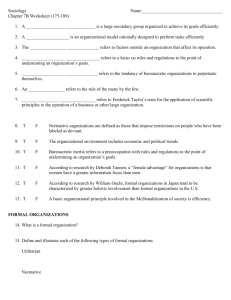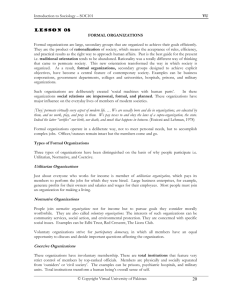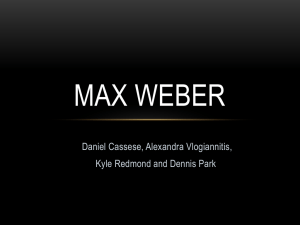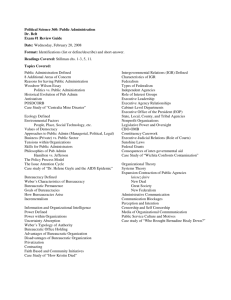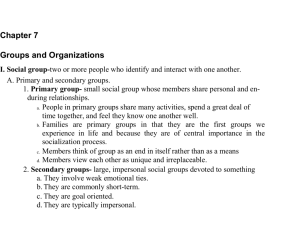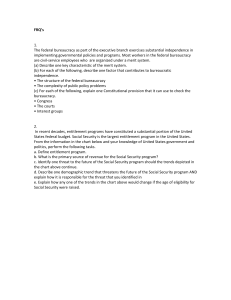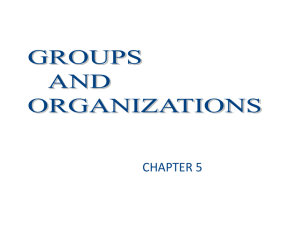Introduction to Sociology Lecture 8 ORGANIZATIONS Formal
advertisement
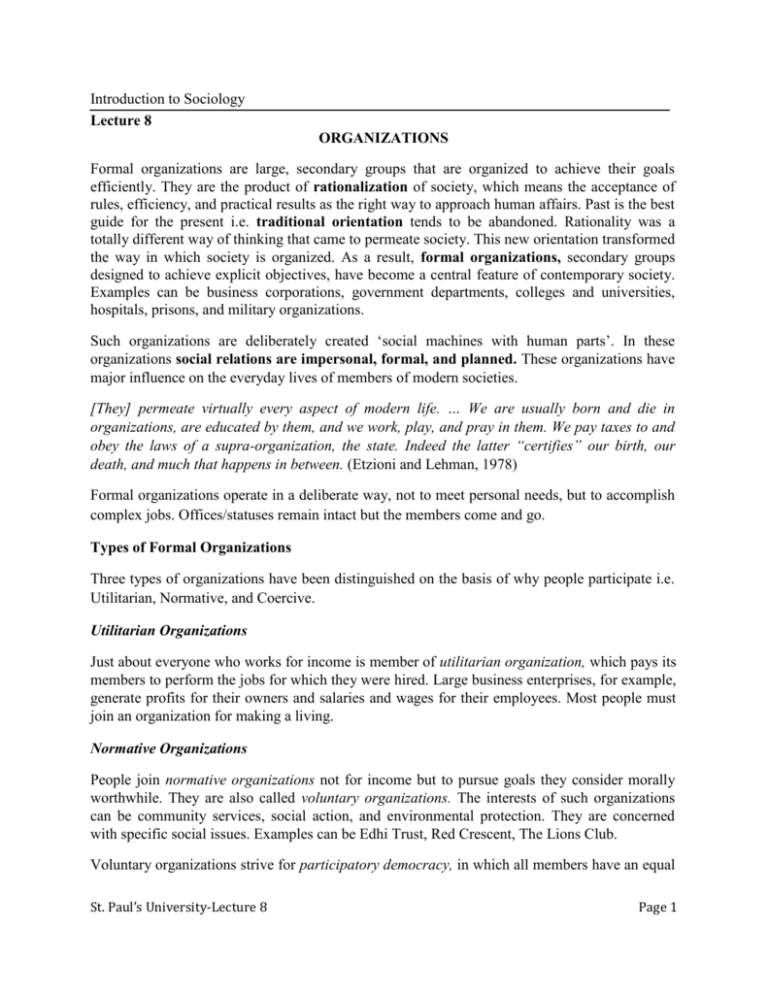
Introduction to Sociology Lecture 8 ORGANIZATIONS Formal organizations are large, secondary groups that are organized to achieve their goals efficiently. They are the product of rationalization of society, which means the acceptance of rules, efficiency, and practical results as the right way to approach human affairs. Past is the best guide for the present i.e. traditional orientation tends to be abandoned. Rationality was a totally different way of thinking that came to permeate society. This new orientation transformed the way in which society is organized. As a result, formal organizations, secondary groups designed to achieve explicit objectives, have become a central feature of contemporary society. Examples can be business corporations, government departments, colleges and universities, hospitals, prisons, and military organizations. Such organizations are deliberately created ‘social machines with human parts’. In these organizations social relations are impersonal, formal, and planned. These organizations have major influence on the everyday lives of members of modern societies. [They] permeate virtually every aspect of modern life. … We are usually born and die in organizations, are educated by them, and we work, play, and pray in them. We pay taxes to and obey the laws of a supra-organization, the state. Indeed the latter “certifies” our birth, our death, and much that happens in between. (Etzioni and Lehman, 1978) Formal organizations operate in a deliberate way, not to meet personal needs, but to accomplish complex jobs. Offices/statuses remain intact but the members come and go. Types of Formal Organizations Three types of organizations have been distinguished on the basis of why people participate i.e. Utilitarian, Normative, and Coercive. Utilitarian Organizations Just about everyone who works for income is member of utilitarian organization, which pays its members to perform the jobs for which they were hired. Large business enterprises, for example, generate profits for their owners and salaries and wages for their employees. Most people must join an organization for making a living. Normative Organizations People join normative organizations not for income but to pursue goals they consider morally worthwhile. They are also called voluntary organizations. The interests of such organizations can be community services, social action, and environmental protection. They are concerned with specific social issues. Examples can be Edhi Trust, Red Crescent, The Lions Club. Voluntary organizations strive for participatory democracy, in which all members have an equal St. Paul’s University-Lecture 8 Page 1 opportunity to discuss and decide important questions affecting the organization. Coercive Organizations These organizations have involuntary membership. These are total institutions that feature very strict control of members by top-ranked officials. Members are physically and socially separated from ‘outsiders’ or ‘civil society’. The examples can be prisons, psychiatric hospitals, and military units. Total institutions transform a human being’s overall sense of self. From differing vantage points, many organizations may fall into all these categories. A psychiatric hospital, for example, serves as a coercive organization for a patient, a utilitarian organization for a health professional, and a normative organization to a hospital volunteer. BUREAUCRACY Bureaucracy is an organizational model rationally designed to perform complex tasks efficiently. In a bureaucratic business or government agency, officials deliberately enact and revise policy to make the organization as efficient as possible. Characteristics of Ideal-Typical Bureaucracy 1. Specialization. There is division of labor in the bureaucracy and each member has a specific task to fulfill. All the tasks are coordinated to accomplish the purpose of the organization. 2. Hierarchy of offices. Bureaucracies arrange the personnel in a vertical ranking. Each person is supervised by ‘higher ups’ and in turn supervising others in lower positions. Usually with fewer people in higher positions, the structure takes the form of a bureaucratic ‘pyramid’. In this hierarchy assignments flow downward and accountability flowing upward. Each level assigns responsibilities to the level beneath it, while each lower level is responsible to the level above for fulfilling these assignments. 3. Written rules and regulations. Rationally enacted rules and regulations control not only the organization’s own functioning but also its larger environment. In general, the longer a bureaucracy exists and the larger it grows, the more written rules it has. 4. Technical competence. A bureaucratic organization expects its officials and staff to have the technical competence to carry out their duties, and regularly monitors worker performance. Evaluation is based on performance and not on favoritism. 5. Impersonality. Rules take precedence over personal whims. Members of a bureaucracy owe allegiance to the office, not to a particular person. The impersonality ensures that the clients as well as workers are all treated uniformly. Each worker in bureaucracy becomes a small cog in a large machine. Each worker is a replaceable unit, for many others are available to fulfill each particular function. From this detached approach St. Paul’s University-Lecture 8 Page 2 stems the notion of the “faceless bureaucrat”. 6. Formal, written communication. Heart of bureaucracy is not people but paperwork. Rather than casual, verbal communication, bureaucracy relies on formal, written memos and reports. Over time, this correspondence accumulates into vast files. Problems of Bureaucracy Bureaucracy can dehumanize and manipulate individuals, and it poses a threat to personal privacy and political democracy. Bureaucratic Alienation Efficiency vs. potential to dehumanize the people it is supposed to serve. The very same impersonality that fosters efficiency keeps officials and clients from responding to each other’s unique, personal needs. Follow bureaucratic procedure. Bureaucratic environment gives rise to alienation where a human being is reduced to a part (cog) of big bureaucratic machinery. Bureaucratic Inefficiency and Ritualism Red tape: The tedious preoccupation with organizational routine and procedures. Rule is a rule. Bureaucratic ritualism (Merton): Preoccupation with rules and regulations to the point of thwarting an organization’s goals. Ritualism stifles individual’s creativity and strangles organizational performance. Modest salary – no stake to perform efficiently – no incentive – all ritualism – and the resultant corruption. Bureaucratic Inertia Bureaucratic inertia refers to the tendency of the bureaucratic organizations to perpetuate them. If bureaucrats have little motivation to be efficient, they certainly have every reason to protect their jobs. Thus the officials typically strive to perpetuate their organization even when its purpose has been fulfilled. St. Paul’s University-Lecture 8 Page 3
